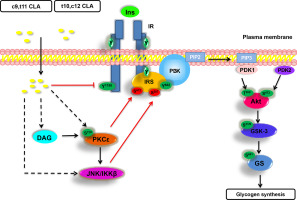当前位置:
X-MOL 学术
›
Cell. Signal.
›
论文详情
Our official English website, www.x-mol.net, welcomes your
feedback! (Note: you will need to create a separate account there.)
Isomers of conjugated linoleic acid induce insulin resistance through a mechanism involving activation of protein kinase Cε in liver cells.
Cellular Signalling ( IF 4.4 ) Pub Date : 2018-10-21 , DOI: 10.1016/j.cellsig.2018.10.013 Adriana Roura-Guiberna 1 , Judith Hernandez-Aranda 1 , Carlos Jorge Ramirez-Flores 1 , Ricardo Mondragon-Flores 1 , Nayely Garibay-Nieto 2 , Gloria Queipo-Garcia 2 , Estibalitz Laresgoiti-Servitje 3 , Jae-Won Soh 4 , Jesus Alberto Olivares-Reyes 1
Cellular Signalling ( IF 4.4 ) Pub Date : 2018-10-21 , DOI: 10.1016/j.cellsig.2018.10.013 Adriana Roura-Guiberna 1 , Judith Hernandez-Aranda 1 , Carlos Jorge Ramirez-Flores 1 , Ricardo Mondragon-Flores 1 , Nayely Garibay-Nieto 2 , Gloria Queipo-Garcia 2 , Estibalitz Laresgoiti-Servitje 3 , Jae-Won Soh 4 , Jesus Alberto Olivares-Reyes 1
Affiliation

|
Conjugated linoleic acid (CLA) constitutes a group of isomers derived from linoleic acid. Diverse studies have suggested that these unsaturated fatty acids have beneficial effects on human health. However, it has also been reported that their consumption can generate alterations in hepatic tissue. Thus, in the present study, we evaluated the effect of two of the major isomers of CLA, cis-9, trans-11-CLA and trans-10, cis-12-CLA, in the regulation of insulin signaling in a hepatic cell model, clone 9 (C9). We found that the two isomers decrease insulin-stimulated phosphorylation of the main proteins involved in insulin signaling, such as Akt at Ser473 and Thr308, the insulin receptor at Tyr1158, IRS-1 at Tyr632, and GSK-3 at Ser9/21. Protein expression, however, was unaffected. Interestingly, both isomers of CLA promoted phosphorylation and activation of PKCε. Inhibition of PKCε activity by a dominant-negative form or knockdown of endogenous PKCε prevented the adverse effects of CLA isomers on insulin-induced Akt phosphorylation. Additionally, we also found that both isomers of CLA increase phosphorylation of IRS-1 at Ser612, a mechanism that probably underlies the inhibition of IRS-1 signaling by PKCε. Using confocal microscopy, we found that both isomers of CLA induced lipid accumulation in C9 cells with the presence of spherical cytosolic vesicles, suggesting their identity as neutral lipid droplets. These findings indicate that cis-9, trans-11-CLA and trans-10, cis-12-CLA isomers could have a significant role in the development of insulin resistance in hepatic C9 cells through IRS-1 serine phosphorylation, PKCε activation, and hepatic lipid accumulation.
中文翻译:

共轭亚油酸的异构体通过涉及肝细胞中蛋白激酶Cε活化的机制诱导胰岛素抵抗。
共轭亚油酸(CLA)构成了一组衍生自亚油酸的异构体。各种研究表明,这些不饱和脂肪酸对人体健康具有有益的作用。但是,也有报道称它们的消耗会在肝组织中产生变化。因此,在本研究中,我们评估了CLA的两个主要异构体cis-9,trans-11-CLA和trans-10,cis-12-CLA在调节肝细胞胰岛素信号中的作用模型,克隆9(C9)。我们发现这两个异构体可降低胰岛素刺激的主要蛋白的胰岛素刺激的磷酸化作用,例如Ser473和Thr308的Akt,Tyr1158的胰岛素受体,Tyr632的IRS-1和Ser9 / 21的GSK-3。然而,蛋白质表达不受影响。有趣的是,CLA的两个异构体均促进PKCε的磷酸化和活化。通过显性负向形式抑制PKCε活性或抑制内源性PKCε可以防止CLA异构体对胰岛素诱导的Akt磷酸化的不利影响。此外,我们还发现CLA的两个异构体均会增加Ser612处IRS-1的磷酸化,这一机制可能是PKCε抑制IRS-1信号传导的基础。使用共聚焦显微镜,我们发现CLA的两个异构体均在球形胞浆囊泡的存在下诱导C9细胞中脂质蓄积,表明它们的身份为中性脂质滴。这些发现表明,通过IRS-1丝氨酸磷酸化,PKCε激活,
更新日期:2018-10-21
中文翻译:

共轭亚油酸的异构体通过涉及肝细胞中蛋白激酶Cε活化的机制诱导胰岛素抵抗。
共轭亚油酸(CLA)构成了一组衍生自亚油酸的异构体。各种研究表明,这些不饱和脂肪酸对人体健康具有有益的作用。但是,也有报道称它们的消耗会在肝组织中产生变化。因此,在本研究中,我们评估了CLA的两个主要异构体cis-9,trans-11-CLA和trans-10,cis-12-CLA在调节肝细胞胰岛素信号中的作用模型,克隆9(C9)。我们发现这两个异构体可降低胰岛素刺激的主要蛋白的胰岛素刺激的磷酸化作用,例如Ser473和Thr308的Akt,Tyr1158的胰岛素受体,Tyr632的IRS-1和Ser9 / 21的GSK-3。然而,蛋白质表达不受影响。有趣的是,CLA的两个异构体均促进PKCε的磷酸化和活化。通过显性负向形式抑制PKCε活性或抑制内源性PKCε可以防止CLA异构体对胰岛素诱导的Akt磷酸化的不利影响。此外,我们还发现CLA的两个异构体均会增加Ser612处IRS-1的磷酸化,这一机制可能是PKCε抑制IRS-1信号传导的基础。使用共聚焦显微镜,我们发现CLA的两个异构体均在球形胞浆囊泡的存在下诱导C9细胞中脂质蓄积,表明它们的身份为中性脂质滴。这些发现表明,通过IRS-1丝氨酸磷酸化,PKCε激活,











































 京公网安备 11010802027423号
京公网安备 11010802027423号